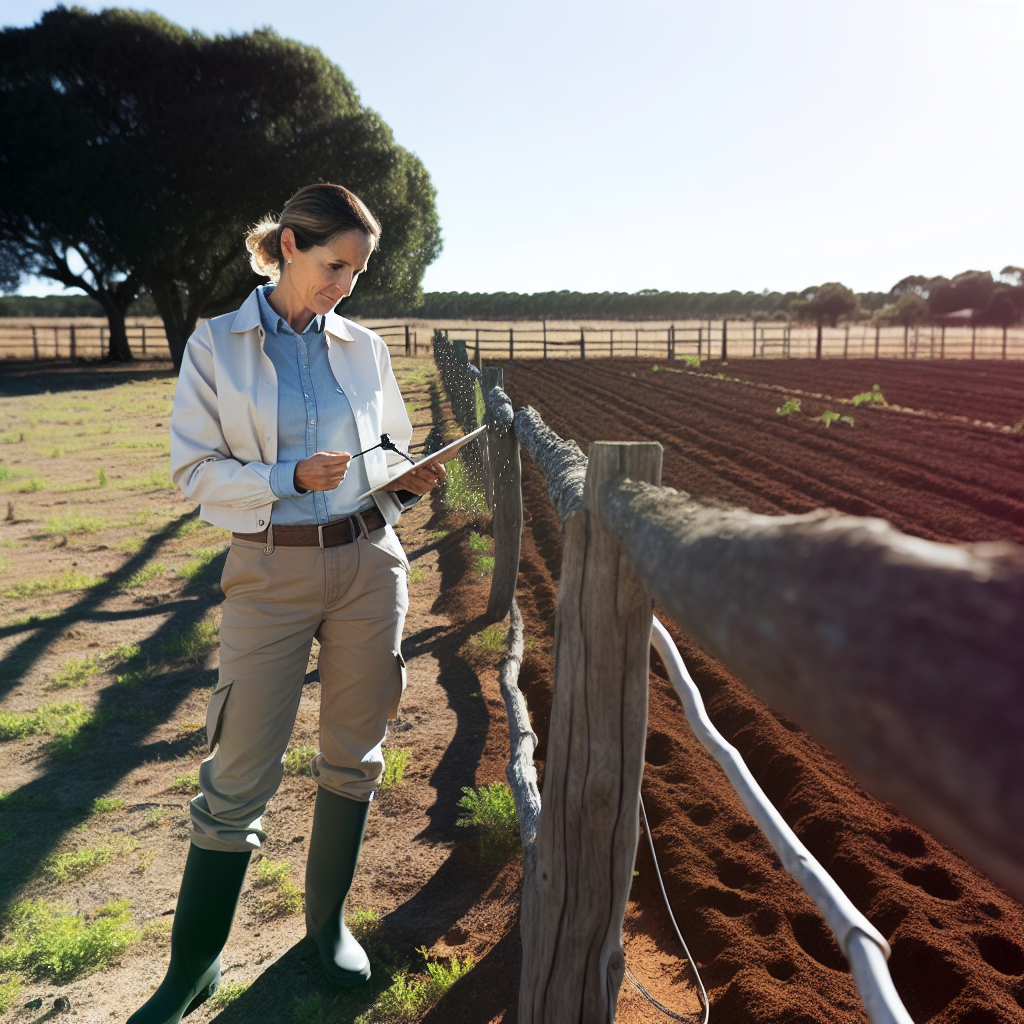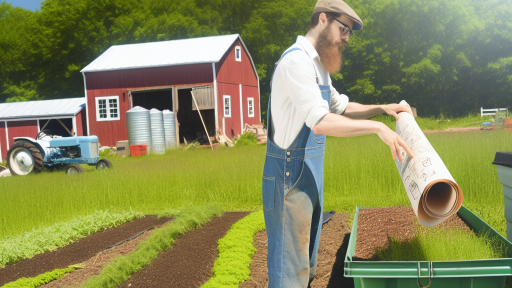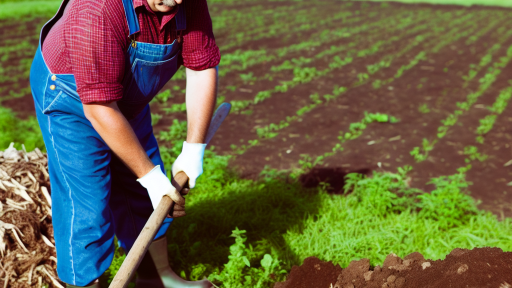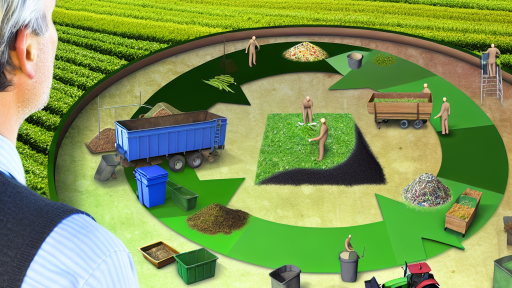Introduction to Soil Health and its Importance in Agriculture
Soil health is vital for sustainable agriculture.
Healthy soil supports crop growth and enhances food security.
It plays a crucial role in the ecosystem.
Soil health affects water management and biodiversity.
Farmers depend on soil for nutrient-rich crops.
Moreover, healthy soil is essential for carbon storage.
This contributes to climate change mitigation.
Components of Soil Health
Soil health comprises physical, chemical, and biological properties.
Physical properties include texture, structure, and porosity.
Chemical properties involve pH, nutrient availability, and organic matter.
Biological properties refer to microbial diversity and activity.
The Role of Organic Matter
Organic matter is a key factor in soil health.
It improves soil structure and nutrient retention.
Additionally, it enhances the water-holding capacity of soil.
Healthy organic matter levels support beneficial microbial activity.
Transform Your Agribusiness
Unlock your farm's potential with expert advice tailored to your needs. Get actionable steps that drive real results.
Get StartedImpacts of Poor Soil Health
Poor soil health leads to reduced crop yields.
It can also result in increased soil erosion.
Furthermore, compromised soil health affects water quality.
This ultimately threatens food security and ecosystem balance.
Integrated Pest Management and Soil Health
Integrated pest management (IPM) practices enhance soil health.
IPM reduces chemical inputs and promotes natural pest control.
This fosters a more diverse soil ecosystem.
Healthy soils can resist pest pressures more effectively.
Understanding Integrated Pest Management Concepts
Defining Integrated Pest Management
Integrated Pest Management (IPM) is a holistic approach to pest control.
This method combines different management strategies for effective results.
IPM emphasizes the importance of observing pest populations.
It integrates biological, cultural, physical, and chemical practices.
The Importance of Soil Health
Soil health plays a vital role in agricultural productivity.
Healthy soil supports beneficial organisms and plant growth.
Integrating IPM helps maintain optimal soil conditions.
This synergy reduces dependency on chemical pesticides.
Components of Successful IPM
Successful IPM relies on various components for effectiveness.
- Pest monitoring to assess the current situation.
- Threshold levels that define when action is necessary.
- Control measures that are economically and environmentally sound.
Additionally, education and outreach are crucial for implementation.
Biological Control Techniques
Biological control uses natural predators or pathogens to manage pests.
This can significantly reduce pest populations without harmful chemicals.
For instance, ladybugs can control aphid infestations effectively.
Farmers often release these organisms to enhance pest management.
Cultural Practices in IPM
Cultural practices modify the farming environment to reduce pest pressure.
Crop rotation disrupts pest life cycles and enhances soil diversity.
Showcase Your Farming Business
Publish your professional farming services profile on our blog for a one-time fee of $200 and reach a dedicated audience of farmers and agribusiness owners.
Publish Your ProfileEngaging in proper sanitation helps eliminate pest habitats.
These strategies are sustainable and promote long-term soil health.
Physical and Mechanical Controls
Physical barriers can protect crops from pests effectively.
For example, installing netting or using traps helps manage infestations.
Mechanical controls, like tilling and handpicking, also contribute to pest reduction.
These methods minimize chemical usage, safeguarding soil health.
Chemical Control in IPM
Chemical controls remain part of IPM but are used wisely.
Choosing targeted pesticides minimizes environmental impact.
Farmers apply chemicals only when monitoring indicates a need.
This reduces the risk of harming beneficial organisms.
The Role of Soil Organisms in Pest Management
Importance of Soil Microorganisms
Soi1 microorganisms play a critical role in pest management.
They contribute to soil health by enhancing nutrient availability.
Additionally, these microorganisms promote plant growth and resilience.
Healthy plants are less susceptible to pest and disease attacks.
Interactions with Pest Populations
Soi1 organisms interact with pest populations in various ways.
Some microorganisms can suppress pest populations effectively.
For instance, beneficial fungi can outcompete harmful pathogens.
Moreover, certain bacteria can produce natural pesticides.
These interactions create a balanced ecosystem in the soil.
Enhancing Soil Biodiversity
Promoting soil biodiversity aids in pest management strategies.
Diversified microbial communities provide stronger pest resistance.
Farmers can enhance biodiversity through cover cropping.
Crop rotation also supports a diverse soil ecosystem.
Effective soil health practices will foster beneficial organisms.
Organic Matter and Soil Health
Organic matter is essential for maintaining soil health.
It provides habitat for beneficial microorganisms and larger soil organisms.
Additionally, organic matter improves soil structure and moisture retention.
Healthy soils, rich in organic matter, support effective pest management.
Implementing Integrated Pest Management
Integrating soil organism knowledge enhances pest management strategies.
Farmers should monitor soil health continuously.
Regular soil testing can inform necessary amendments.
Targeted use of organic amendments will bolster beneficial organisms.
Finally, education on soil management practices is vital.
Delve into the Subject: IPM Best Practices for Sustainable Agriculture
Strategies for Enhancing Soil Health through IPM Practices
Implementing Cover Crops
Cover crops play a vital role in soil health enhancement.
They protect soil from erosion during off-seasons.
Additionally, they improve soil structure and organic matter content.
Planting legumes as cover crops boosts nitrogen levels.
Therefore, it reduces the need for synthetic fertilizers.
Promoting Biodiversity
Biodiversity on the farm is crucial for pest management.
Showcase Your Farming Business
Publish your professional farming services profile on our blog for a one-time fee of $200 and reach a dedicated audience of farmers and agribusiness owners.
Publish Your ProfileIt creates a resilient ecosystem capable of natural pest control.
Encouraging beneficial insects supports pest population control.
Diverse crop rotations can interrupt pest life cycles effectively.
Consequently, this practice minimizes crop damage and increases yields.
Utilizing Organic Amendments
Organic amendments significantly enhance soil health.
Compost adds organic matter while improving nutrient availability.
Furthermore, it boosts microbial activity in the soil.
Worm castings serve as a potent organic fertilizer.
Integrating these amendments fosters a supportive environment for plants.
Implementing Integrated Pest Management Techniques
IPM combines multiple strategies for effective pest control.
Monitoring pest populations allows for informed decision-making.
Biological controls, such as predators or parasites, can suppress pests.
Physical barriers can also protect crops without harmful chemicals.
By reducing pesticide use, soil health and biodiversity thrive.
Encouraging Soil Organism Activity
Healthy soil relies on active organisms for nutrient cycling.
Practices that support beneficial fungi enhance soil structure.
Applying mycorrhizal fungi improves plant nutrient absorption.
Additionally, minimizing tillage preserves soil organisms and structure.
As a result, the overall health of the soil improves dramatically.
Discover More: Composting Basics For Better Soil Health
Case Studies: Successful Implementation of IPM for Soil Health
Case Study: Green Valley Farm
Green Valley Farm made remarkable improvements in soil health through Integrated Pest Management (IPM).
They focused on building natural pest resilience in the ecosystem.
As a result, their soil organic matter increased significantly over three years.
This transformation reduced the need for chemical pesticides.
Additionally, the farm grew a variety of cover crops to enhance nutrient cycling.
Finally, farmers adopted crop rotation strategies to disrupt pest cycles.
Case Study: Willow Creek Orchards
Willow Creek Orchards achieved success with its pest management practices.
They implemented beneficial insect habitats to promote native pollinators.
This strategy ultimately increased fruit yield and diversity.
Moreover, they regularly monitored pest populations to apply targeted interventions.
They also used pheromone traps to reduce pest mating and reproduction.
This sustainable approach preserved soil health over multiple growing seasons.
Case Study: Riverbend Community Garden
Riverbend Community Garden utilized community involvement in their IPM efforts.
Families participated in identifying pests and assessing plant health.
This education led to effective pest monitoring and timely interventions.
Moreover, the garden incorporated composting practices to enrich soil fertility.
The result was a vibrant garden ecosystem with reduced pest issues.
Community members celebrated both their environmental and agricultural achievements.
Case Study: Evergreen Agricultural Cooperative
Evergreen Agricultural Cooperative focused on education and training for sustainable farming practices.
They organized workshops on the benefits of IPM techniques for local farmers.
Showcase Your Farming Business
Publish your professional farming services profile on our blog for a one-time fee of $200 and reach a dedicated audience of farmers and agribusiness owners.
Publish Your ProfileAs a result, cooperative members adopted methods that enhance soil structure.
They shared their experiences with ladybugs and other beneficial insects.
This collective knowledge reduced dependency on chemical pesticides across the region.
Ultimately, soil health improved across all member farms, fostering resilience and productivity.
Case Study: Blue Skies Vineyard
Blue Skies Vineyard carried out an innovative approach to pest management.
They introduced companion planting to deter harmful insects.
For instance, marigolds planted near grapes repelled nematodes effectively.
Furthermore, this technique improved soil moisture retention and biodiversity.
Farmers practiced strict sanitation to mitigate disease spread.
The vineyard’s commitment to IPM led to healthier vines and improved soil conditions.
Explore Further: Implementing Agroforestry for Water Efficiency

Impact of Chemical Pesticides on Soil Health
Negative Effects on Soil Microorganisms
Chemical pesticides can disrupt the balance of soil microorganisms.
These microbes play essential roles in nutrient cycling.
When affected, soil fertility declines significantly.
This leads to reduced crop yields over time.
Soil Structure Degradation
Chemical pesticides can alter soil structure and composition.
Compacted soil results from these changes.
Compaction reduces water infiltration and root penetration.
Consequently, plant health suffers due to limited access to nutrients.
Contamination of Water Supplies
Pesticides often leach into groundwater, causing contamination.
This spreads harmful chemicals well beyond the target area.
Consequently, ecosystems and drinking water sources are at risk.
Moreover, this impacts overall biodiversity in affected areas.
Alternative Pest Management Strategies
Various alternatives exist to mitigate these negative impacts.
Integrated Pest Management (IPM) offers holistic solutions.
Biological control involves using natural predators for pest control.
Additionally, crop rotation can disrupt pest life cycles effectively.
Moreover, organic pesticides present a safer option.
Promoting Natural Soil Health
Implementing cover crops enhances soil structure and fertility.
These crops protect the soil from erosion while adding organic matter.
Moreover, they provide habitats for beneficial organisms.
Incorporating compost enriches soil nutrient levels safely.
Ultimately, these practices promote sustainable agricultural systems.
Learn More: Cover Crops for Enhanced Carbon Sequestration
Monitoring and Assessing Soil Health Metrics in IPM Programs
The Importance of Soil Health in IPM
Soi l health significantly influences crop productivity.
Healthy soil promotes balanced ecosystems.
Effective pest management relies on robust soil health metrics.
Key Soil Health Metrics to Monitor
Monitoring organic matter content is essential.
Soil pH levels affect nutrient availability.
Assessing microbial activity provides insights into soil vitality.
Showcase Your Farming Business
Publish your professional farming services profile on our blog for a one-time fee of $200 and reach a dedicated audience of farmers and agribusiness owners.
Publish Your ProfileMeasuring moisture retention helps in understanding soil structure.
Organic Matter Content
Organic matter enhances soil fertility and structure.
It supports beneficial microorganisms in the soil.
Soil pH
Soil pH directly influences nutrient mobilization.
Plants thrive in optimal pH ranges specific to species.
Microbial Activity
Microbial communities play vital roles in nutrient cycling.
Expressive microbial activity can suppress harmful pests.
Moisture Retention
Effective moisture management supports crop resilience.
Soil texture and organic matter influence moisture levels.
Methods for Monitoring Soil Health
Using soil tests helps assess nutrient levels accurately.
Regular visual assessments provide immediate insights.
Utilizing remote sensing technologies enhances data collection.
Engaging in farmer-led soil health assessments strengthens knowledge.
Soil Testing Techniques
Lab analysis provides in-depth nutrient profiles.
In-field tests offer quick evaluations during the growing season.
Visual Assessments
Farmers can monitor plant health and growth patterns.
Identifying pest outbreaks early allows for timely responses.
Remote Sensing Technologies
Satellite imagery aids in large-scale soil assessments.
Drones enhance precision agriculture monitoring capabilities.
Integrating Findings into IPM Strategies
Information gathered must inform pest management practices.
Adjusting management techniques based on soil health data increases efficacy.
Collaboration among stakeholders enhances program success.
Adapting IPM Approaches
Using diagnostic tools tailors solutions for specific pest issues.
Collaboration creates a holistic approach to pest management.
Stakeholder Collaboration
Farmers, agronomists, and researchers must work together.
Sharing knowledge and resources strengthens IPM programs.
Future Trends in IPM and Soil Health Improvement
Advancements in Technology
Technology plays a crucial role in pest management and soil health.
Innovations in remote sensing make it easier to monitor crop health.
Farmers can use drones for targeted pest control applications.
Moreover, soil sensors provide real-time data on nutrient levels.
This technology enables timely interventions to enhance soil conditions.
Increased Focus on Biodiversity
Biodiversity significantly contributes to sustainable agricultural practices.
Integrating diverse crops improves soil structure and health.
Additionally, natural pest predators can help manage pest populations.
Farmers are adopting polyculture systems for better resilience.
Such systems also boost overall ecosystem services on farms.
Regenerative Agricultural Practices
Regenerative practices enhance soil health and pest management.
Cover cropping and crop rotation foster healthy soil ecosystems.
These practices improve soil organic matter and moisture retention.
Furthermore, they reduce reliance on chemical inputs.
Showcase Your Farming Business
Publish your professional farming services profile on our blog for a one-time fee of $200 and reach a dedicated audience of farmers and agribusiness owners.
Publish Your ProfileFarmers are increasingly adopting these methods for sustainability.
Collaboration and Knowledge Sharing
Collaboration among farmers improves the effectiveness of IPM strategies.
Knowledge-sharing platforms facilitate access to best practices.
Local farming cooperatives encourage collective pest management efforts.
Such initiatives strengthen community resilience against crop threats.
Education programs help farmers stay informed about new methods.
Regulatory Changes and Support
Governments are increasingly recognizing the importance of IPM practices.
Supportive policies incentivize sustainable pest management approaches.
Funding programs encourage the adoption of environmentally friendly methods.
Regulatory changes aim to simplify the application of IPM programs.
Such support accelerates the transition to healthier farming systems.




